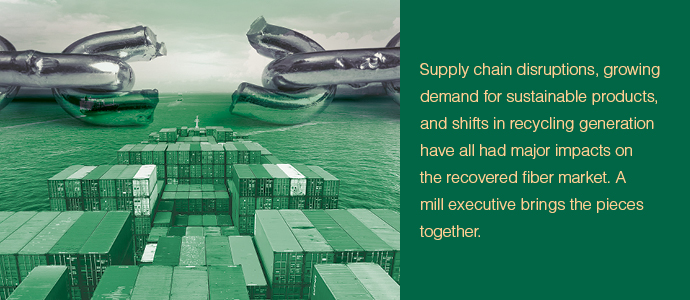
This article appeared in the February 2022 issue of Resource Recycling. Subscribe today for access to all print content.
Sustana Fiber, a recycled paper mill operator with facilities in the U.S. and Canada, has felt the impact of global supply chain disruptions in both its feedstock supply and product demand. And a company executive says the challenges are set to continue.
Wisconsin-headquartered Sustana operates a recycled fiber mill in Lévis, Quebec; a recycled paper mill and converting facility in St-Jérôme, Quebec; and a recycled fiber mill in De Pere, Wis. For its recycled pulp output, Sustana produces 155,000 short tons per year at its De Pere mill and 100,000 short tons per year at the Lévis plant.

Renee Yardley
The company takes in recovered fiber from a variety of sources, a fact that has given Sustana a firsthand look at how fiber generation has shifted over the course of the COVID-19 pandemic. Sustana also uses that material to create a variety of products in different markets, meaning the company is well-positioned to take stock of demand changes as well.
Renee Yardley, senior vice president of sales and marketing at Sustana, recently laid out some of the supply chain impacts and how the company is planning for similar uncertainties in the future. She also described other trends that could impact the recycling space, including growing consumer preference for recycled-content products and potential opportunities for more fiber recovery as brands switch from plastic to paper packaging.
This conversation, which took place in December of last year, has been edited for clarity and brevity.
Resource Recycling: We hear a lot about the supply chain being disrupted and experiencing challenges. Tell me about what you’ve seen on this front in recovered paper.
Renee Yardley: I think it depends on what point in the supply chain you’re really asking about. On our fiber side, with our Sustana mills, there’s a number of impacts that we’re feeling. There hasn’t been a lot of generation of recyclable materials coming into the mill. We thought that the generation of recyclable materials would pick up faster than it did, but people didn’t go back to the offices and schools as quickly as we thought they were going to.
The e-commerce demand and demand for OCC has been so high. That’s been driving pricing on the OCC side. And then on the trucking side, just the actual shortage of truckers in the U.S. has affected us.
On the paper side, with Sustana we also have a paper mill in St. Jerome, Quebec, so the complexity is added in there. You’ve got shipping container shortages. And with the lack of paper coming into North America from offshore, people are looking for domestic supply. They’re searching for mills here, which is making our demand go through the roof.
It sounds like you’re seeing changes in the supply of feedstock to run your operations, in the demand for end products, and then every point in the logistical chain of moving materials and getting products. When should we anticipate the supply chain challenges easing?
This is a shot in the dark, because we don’t know when the international shipping issues are going to be relieved, the port congestion that everyone is facing. I don’t see that being relieved in the next 12 months. I could confidently state that we’re in it for at least 12 more months. For an economist, a short-term problem is 18 to 24 months. But when you’re living that, that can seem like a really long time.
Do you tie this to COVID? It sounds like shifting generation due to COVID changes may have been one of the initial impacts you saw.
Yes, I would say that COVID was the start of everything. Our shredder in Breakeyville (Quebec) was one of the innovations we took on during COVID. When we had that disruption in the generation of the feedstock, we had to find other sources of feedstock, so we moved to the aseptic containers and gable top containers, because it’s great fiber for recycling. It really got us moving on that innovation during COVID with the other generation decreasing.
What changes have you seen in the end uses for Sustana’s products?
It’s shifted over COVID. We saw an increase in tissue demand, obviously, during COVID. There is more demand for the EnviroNatural [a recycled fiber product manufactured by Sustana and used in take-out containers and other foodservice items]. Also, during COVID with the supply chain issues, there was an increase in taking the recycled fiber because you can use it as a substitute for hardwood, things that were not readily available. With the increase in demand, we saw a subsequent increase in pulp sales as well.
At the beginning of 2021, there was a lot of downtime in the pulp mills around the world, and all of a sudden the spike in demand came back for paper. It’s a perfect economic storm. The supply had gone down and all of a sudden the demand went up, and we felt that impact as well.
I’m also finding increased interest in using recycled fiber as well. During COVID, people had time to start thinking about sustainability and the circular economy. We started to get a lot more inquiries during COVID. Sustainability and recycling are certainly more in the consumer’s mind.
That’s joined the growing amount of corporate sustainability pledges we’re seeing. We’re seeing it on both fronts now, and it seems the consumer interest is driving businesses to do that too.
Absolutely, consumers are demanding that companies be more sustainable, so they’re looking at their supply chain and where they can make changes in the supply chain, particularly with the circular economy. Some of the research is telling us that they’ll pay more for sustainable products over non-sustainable products.
So when you’re looking at a 12–month period of disruption where it’s unclear what will happen, how do you approach that as a business? How do you approach complete uncertainty specific to the recycling side of this and sourcing fiber?
I think 2020 and 2021 provided good preparation for working with uncertainty. We’ll find innovative ways for the fiber like we did with our two mills using the aseptic and gable top containers. Say, for example, there are restrictions again and generation goes down, then we’ll look at how we increase usage of those products over the sorted office paper if that starts to dry up again. We’ve got people looking out several months in advance. It’s supply and demand, so they’re looking at the recyclers that we work with, trends in the industry, what the other mills are purchasing, making sure that we’re well-supplied.
The shift in fiber generation is something the recycling sector has been preparing for for some time – the declines in newsprint and office paper have been in progress for years. Was some of this work of looking to new sources of fiber inevitable, with or without COVID?
Absolutely. For example, we’ve been part of the Paper Cup Alliance for quite a while. You will hear out in the marketplace that paper cups can’t be recycled, and that’s not accurate. They can be recycled. We did a pilot project with Starbucks showing how we could recycle those cups. There are two elements of it: There’s the new source of fiber and the innovative process so we can get the poly lining out and recycle the fiber in the cups. So it’s an innovative manufacturing process. It’s a new source of fiber and a focus on the circular economy.
So we’re always going to be looking for that and working with the brands to put that recycled content back in their packaging so that we are completing that loop in the circular economy.
That sort of communication – recycling operators and mills working directly with brand owners – seems to be a key component of increasing both recovery and recycled content use.
I think that’s why organizations like the Paper Cup Alliance, those types of organizations are critical in the recycling field, so we can all get together and work on those issues. It’s not just Sustana doing the recycling; it’s also the other mills using the recycled fiber and ultimately getting it back to the brand owners to use in their products.
We’ve talked about cups and cartons. Do you see any opportunities to tackle new waste fiber streams that we aren’t even thinking about right now?
Paper is already one of the most recycled products out there, and with our EnviroLife product we’re able to put the EnviroLife directly into food contact, it’s FDA compliant so it can go in there. I see with the switch from plastic to fiber-based products, there’s a lot of the single-use plastics that are going away. So off the top of my head I don’t have a particular opportunity, but I see as we switch more away from those single-use plastics into fiber-based products, that there will be more areas of opportunity.
What role do you see the recycling sector playing in easing the supply chain disruptions? What does that look like?
It’s all about using our resources wisely. Instead of linear manufacturing, we look at the circular economy. If we’re sourcing materials that we can reuse, then we don’t have to bring them in from other places. That’s one element where I think we can really help out in the supply chain – extending the life of the resources.
Colin Staub was the staff reporter for Resource Recycling until the end of 2021. He is now staff reporter at the Northwest Labor Press.
This article appeared in the February 2022 issue of Resource Recycling. Subscribe today for access to all print content.

